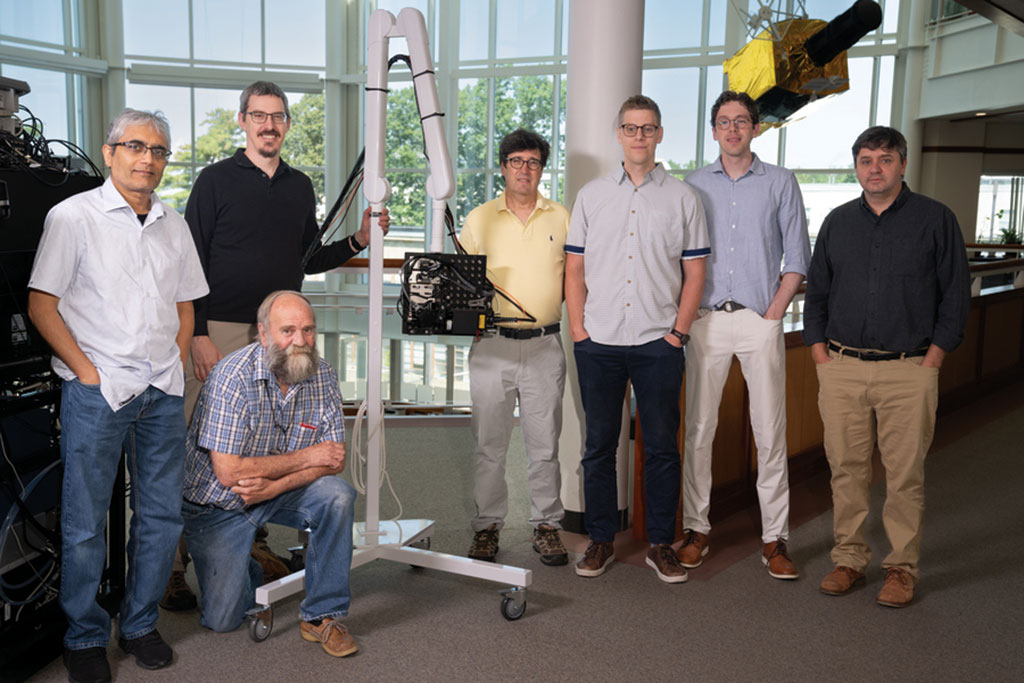Noncontact Laser-Based Ultrasound System Delivers Same Performance as MRI and CT at Lower Cost
Posted on 04 Sep 2023
Ultrasound is routinely employed by medical professionals to aid in the assessment and diagnosis of a wide array of health conditions, diseases, and injuries. Through ultrasound, doctors can obtain noninvasive insights into the body's internal structures, imaging various tissues and their shapes. Ultrasound is also capable of measuring the pulsating blood flow within arteries and veins, as well as assessing the mechanical attributes (elastography) of organs and tissues. While modern medical ultrasound systems excel in capturing tissue details with submillimeter precision, they are not without limitations. Challenges such as image distortion caused by sonographers applying pressure to the probe by feel, and positional reference uncertainty, or operator variability, hamper the technology’s ability to track conditions like cancerous tumors. Consequently, more expensive techniques like magnetic resonance imaging (MRI) and computerized tomography (CT) are often employed to monitor disease progression, despite their greater complexity, larger size, higher cost, and potential radiation risks. Now, a noncontact laser ultrasound system has emerged as a cost-effective alternative, delivering capabilities similar to MRI and CT on a portable, automated platform.
Researchers at Massachusetts Institute of Technology (MIT, Cambridge, MA, USA) and their collaborators at the Massachusetts General Hospital (Boston, MA, USA) have developed a new medical imaging device called the Noncontact Laser Ultrasound (NCLUS). This laser-based ultrasound system generates images of interior body features like organs, fat, muscles, tendons, and blood vessels. NCLUS uses a pulsed laser that transmits optical energy through the air to the skin's surface. The skin absorbs the light rapidly upon contact, inducing localized heating and rapid skin deformation via a thermoelastic process. This deformation promptly generates ultrasonic waves, serving as a source of ultrasound through a phenomenon known as photoacoustics. The optical pulse yields ample ultrasound power with frequencies comparable to traditional medical ultrasound, all while producing no discernible sensation on the skin. The ultrasound echoes originating from deeper tissues emerge as localized vibrations at the skin's surface, which are captured by a specialized and highly sensitive laser Doppler vibrometer.

NCLUS’ fully automated ultrasound image acquisition process offers the potential to reduce the need for a sonographer and eliminate operator variability. Precise laser positioning ensures reproducibility, eliminating variability across repeated measurements. Importantly, since NCLUS operates without direct contact, there is no tissue compaction or related distortion of image features. Similar to MRI and CT, NCLUS employs skin markers to establish a fixed reference frame capability, allowing for reproduction and comparison of repeat scans over time. To facilitate such tracking capabilities, the research team has developed software that processes ultrasound images and detects any differences between them. Since NCLUS requires no manual pressure or coupling gels (unlike contact probes), it can be particularly suitable for patients with sensitive or painful body areas, frail conditions, or infection risks. Additionally, the system measures bone strength and holds promise for monitoring stages of disease progression.
The research team validated the system's performance using a gel-based puck mimicking the mechanical properties of human tissue, known as a phantom, that regulates ultrasound wave propagation. The team is now developing NCLUS for military applications, including the detection and characterization of life-threatening internal bleeding, monitoring musculoskeletal injuries and recovery, and offering elastographic images of amputee limb regions to expedite design and fitting of prosthetic sockets. Civilian applications of NCLUS include imaging in the intensive care unit. The next phase of the NCLUS initiative involves conducting clinical studies using a laser that ensures skin safety, with the aim of comparing ultrasound images with conventional medical ultrasound. If successful, the team will seek commercial funding for clinical medical device development, followed by approval from the U.S. Food and Drug Administration.
“Variability has been a major limitation of medical ultrasound for decades," said Anthony Samir, associate chair of Imaging Sciences at Massachusetts General Hospital radiology. "With further development, NCLUS has the potential to be a transformative technology: an automated, portable ultrasound platform with a fixed-reference-frame capability similar to that of MRI and CT."
Related Links:
MIT
Massachusetts General Hospital














